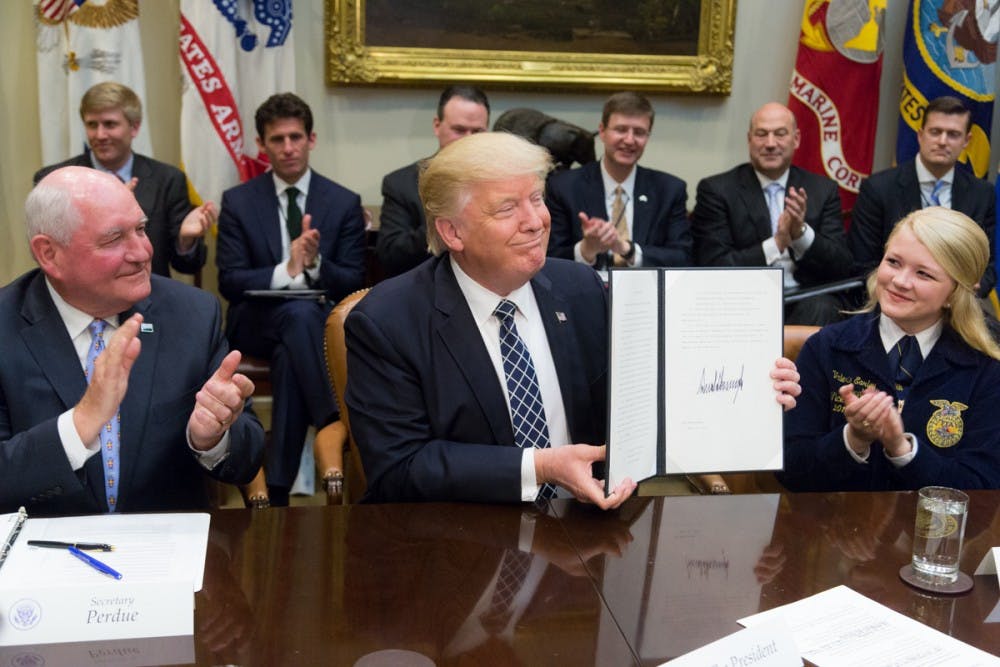In both the 2016 general election and in the first two years of the Trump Administration, higher education policy regarding important issues such as upholding free speech and reducing student debt have largely taken a back seat to more controversial topics, such as immigration or healthcare. Following the 2018 midterm elections, the president is now bringing higher education to the main stage through public speeches, executive orders and recently proposed legislation.
One of these actions is Trump’s recent executive order which makes federal funding to public colleges and universities contingent on them maintaining free speech standards. These actions come at a time where free speech is under attack on colleges and universities across the United States, particularly for conservative students. The free-speech group FIRE estimates that 9 in 10 colleges restrict students’ First Amendment rights. These attempts to restrict free speech include many examples – from Liberty University attempting to silence their campus newspaper to Dixie State University not allowing a student group to criticize Presidents Bush and Obama and confining them to a “free speech zone.”
These administrative limits on free speech have, in part, contributed to an environment that is openly hostile to any semblance of conservative thought on college campuses. While the left used to celebrate free speech as a necessary and vibrant part of college campuses during times such as the Vietnam War, they have abandoned these principles in recent years. From “speech codes” to “free speech zones,” the left — with the ACLU being a notable exception — has contributed to shutting down freedom of thought on college campuses. These regulations proposed by some colleges have led to what Harvard Professor Jill Lepore calls “an unwillingness to engage with conservative thought, an aversion to debate, and a weakened commitment to free speech.”
Examples of the extreme polarization caused by the attack on free speech can be seen in the case of conservative activist Hayden Williams, who was physically assaulted at the University of California, Berkeley for expressing his beliefs. Trump chose to highlight this violent attack on free speech at the annual Conservative Political Action Conference, where he not only made the issue of free speech one of his top concerns but also invited Hayden to join him on stage and say a few words.
Our University has taken some recent actions that are worrisome in regards to limiting free speech on Grounds, such as forcing unaffiliated groups to register before exercising speech on Grounds and relegating them to specified locations. Make no mistake, this policy attempts to control the speech of those unaffiliated with the University while on Grounds, therefore limiting their First Amendment rights at a public university that their tax dollars help fund. Such restrictions could be placed on students and CIOs next. But even with these recent changes, the University thankfully has a mostly positive record on protecting free speech. This was demonstrated by their actions to help the Batten School host former Congressman Tom Garrett’s town hall in 2017, despite controversy and threats of violence. The University currently receives a green-light rating from FIRE, the highest free speech rating the organization gives. With President Trump’s executive order and a renewed focus on protecting free speech, hopefully, First Amendment rights will continue to be protected at the University, as well as college campuses across the nation.
In addition to his executive order on free speech, Trump has been pushing for legislation to give the Higher Education Act its first major update since 2008. While some of the new proposals are more controversial and need to be debated and resolved — such as capping the total amount students can borrow or eliminating the Public Loan Forgiveness Program — many of them are common-sense ideas that already have some support in Congress. These proposals include allowing low-income students to use Pell Grants for short-term academic programs, expanding federal aid to prisoners who are eligible for release and streamlining loan repayment. Implementation of these proposals would expand opportunity and give more choices to those who need help the most, which is something any higher education proposal must strive to do. The president and Congress should work to pass these bipartisan reforms as well as debate and resolve the more controversial aspects of the Higher Education Act proposal.
The President’s proposals regarding higher education free speech are not only promising by themselves but also shows the power that students have going into the 2020 elections. With increasing student turnout during the 2018 election, Trump is clearly attempting to make gains among college students across the country, at a time when many 2020 Democratic hopefuls are attempting to do the same. The President’s renewed focus on higher education is a direct example of the power of how student voting in elections and activism on Grounds can impact the national conversation for the better.
Adam Kimelman is a Viewpoint Columnist for The Cavalier Daily. He can be reached at opinion@cavalierdaily.com.







